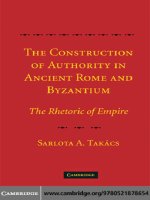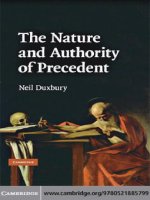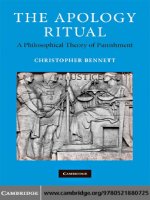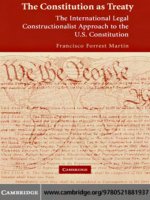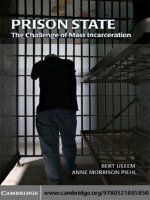cambridge university press the construction of authority in ancient rome and byzantium the rhetoric of empire sep 2008 kho tài liệu bách khoa
Bạn đang xem bản rút gọn của tài liệu. Xem và tải ngay bản đầy đủ của tài liệu tại đây (1.75 MB, 193 trang )
This page intentionally left blank
The Construction of Authority in
Ancient Rome and Byzantium
ᇺ
The Rhetoric of Empire
In The Construction of Authority in Ancient Rome and Byzantium, Sarolta
Tak´acs examines the role of the Roman emperor, who was the single
most important law-giving authority in Roman society. Emperors
had to embody the qualities or virtues espoused by Rome’s ruling
classes. Political rhetoric shaped the ancients’ reality and played a part
in the upkeep of their political structures. Tak´acs isolates a reoccurring cultural pattern, a conscious appropriation of symbols and signs
(verbal and visual) belonging to the Roman Empire. She suggests that
contemporary concepts of “empire” may have Roman precedents,
which are reactivations or reuses of well-established ancient patterns. Showing the dialectical interactivity between the constructed
past and present, Tak´acs also focuses on the issue of classical legacy
through these virtues, which are not simply repeated or adapted cultural patterns but are tools for the legitimization of political power,
authority, and even domination of one nation over another.
Sarolta A. Tak a´ cs is professor of history and founding dean of the
School of Arts and Sciences Honors Program at Rutgers University.
A recipient of fellowships from the Center for Hellenic Studies
(Harvard University) and the Alexander von Humboldt Foundation
as well as grants from the Loeb Classical Library Foundation, the
Ford Foundation, and Fondation Hardt, she is the author of Isis and
Sarapis in the Roman World and Virgins, Sibyls, and Matrons: Women in
Roman Religion.
ᇺᇺᇺᇺᇺᇺᇺᇺᇺ
The Construction of
Authority in
Ancient Rome and
Byzantium
The Rhetoric of Empire
ᇺᇺᇺ
Sarolta A. Tak a´ cs
Rutgers University
CAMBRIDGE UNIVERSITY PRESS
Cambridge, New York, Melbourne, Madrid, Cape Town, Singapore, São Paulo
Cambridge University Press
The Edinburgh Building, Cambridge CB2 8RU, UK
Published in the United States of America by Cambridge University Press, New York
www.cambridge.org
Information on this title: www.cambridge.org/9780521878654
© Sarolta A. Takacs 2009
This publication is in copyright. Subject to statutory exception and to the provision of
relevant collective licensing agreements, no reproduction of any part may take place
without the written permission of Cambridge University Press.
First published in print format 2008
ISBN-13 978-0-511-42338-3
eBook (EBL)
ISBN-13 978-0-521-87865-4
hardback
Cambridge University Press has no responsibility for the persistence or accuracy of urls
for external or third-party internet websites referred to in this publication, and does not
guarantee that any content on such websites is, or will remain, accurate or appropriate.
To My Friends
Inspirations and Psych¯es Iatroi
And
To My Teachers
Motivators of Ideas and Questions
Contents
Acknowledgments
Abbreviations
Maps
Introduction
page ix
xi
xv
xvii
chapte r one
Republican Rome’s Rhetorical Pattern of Political Authority
Virtual Reality: To Win Fame and Practice Virtue
Creation of a Public Image: Rome’s Virtuous Man
Virtue and Remembrance: The Tomb of the Scipiones
Variations on the Theme: Cicero’s Virtuous Roman
Pater Patriae: Symbol of Authority and Embodiment of
Tradition
The Virtuous Father: Gaius Julius Caesar
chapte r two
Empire of Words and Men
Augustus’s Achievements: A Memory Shaped
Horace’s Poem 3.2: Dulce et decorum est pro patria mori
vii
1
1
4
16
24
32
36
40
40
50
viii / Contents
Nero: What an Artist Dies with Me!
Vespasian: The Upstart from Reate
Trajan: Jupiter on Earth
Maximus: Hollywood’s Ideal Roman
55
62
73
77
chapte r thre e
Appropriation of a Pattern
Mending the Known World Order
A New World Order
Constantine, Very Wisely, Seldom Said “No”
A Pagan’s Last Stand
Augustine: The Christian Cicero
Claudian’s On the Fourth Consulate of Honorius
81
81
89
94
99
107
112
chapte r four
The Power of Rhetoric
The Last Roman Emperor: Justinian
The First Byzantine Emperor: Heraclius
A View to the West: Charlemagne
Back to the East: A Theocratic State?
119
119
127
134
139
Conclusion
147
Bibliography
Ancient Authors
Modern Authors
Index
155
155
156
165
Acknowledgments
I benefited greatly from discussions with Professor Phillip Rothwell
in the early stages of writing this book. The actual book took shape
while I was a Fellow at the Rutgers Center for Historical Research,
where, under the directorship of Professors Ann Fabian and Jackson
Lears, we explored “The Question of the West.” I am grateful
to them and to all the other Fellows who welcomed an ancient
historian and helped me rethink many of my assumptions. Thanks
goes also to my Rutgers University research assistants, Mr. David
Danbeck, Mr. Andrij Fomin, and Ms. Anna Linden Weller, as well
as the anonymous readers from the Cambridge University Press. Mr.
Paul Blaney for his editorial assistance and Ms. Maureen DeKaser for
her unceasing and passionate encouragement as well as her help over
many years deserve my deepest gratitude. To all of them, teachers
and friends, I dedicate this book.
Rutgers, The State University of New Jersey
New Brunswick, NJ
Fall 2007
ix
Abbreviations
AE
L’Ann´ee e´pigraphique
AHR
The American Historical Review
BMCRE
British Museum Coins of the Roman Empire
CIL
Corpus inscriptionum Latinarum
HThR
Harvard Theological Review
IG
Inscriptiones Graecae
IGUR
Inscriptiones Graecae urbis Romae
ILS
Inscriptiones Latinae selectae
MGH Poet. Lat. Monumenta Germaniae historica poetae Latini
OCD
Oxford Classical Dictionary
OLD
Oxford Latin Dictionary
RE
Realencyclop¨adie der Altertumswissenschaften
(Pauly-Wissowa)
REB
Revue des e´tudes byzantines
REL
Revue des e´tudes latines
RhM
Rheinisches Museum
TAPA
Transactions of the American Philological Association
WS
Wiener Studien
ZPE
Zeitschrift f¨ur Papyrologie and Epigraphik
xi
xii / Abbreviations
Abbreviations of Ancient Authors
Ach. Tat.
Aug.
RG
August.
C.D.
Basil
Ad. adol.
Cato
Origines
Cic.
Arch.
Fin.
Marc.
Phil.
Pis.
Rab. Perd.
Sest.
Ver.
D.C.
D.H.
Enn.
Ann.
Euseb.
Hist. eccl.
Vit. Const.
G. Pis.
Ex. Pers.
Rest. Cruc.
Isoc.
Arch.
J.
BJ
Achilles Tatius
C. Iulius Caesar (Octavianus) Augustus
Res Gestae
Augustine
De civitate Dei
Basil of Caesarea
Oratio ad adolescentes
M. Porcius Cato
M. Tullius Cicero.
Pro Archia
De Finibus Bonorum et Malorum.
Pro Marcello
Philippicae
In Pisonem
Pro Rabirio Peduellionis Reo
Pro Sestio
In Verrem
Dio Cassius
Dionysius of Halicarnassus
Ennius
Annales
Eusebius
Historia ecclesiastica
Vita Constantini
George of Pisidia
Expeditio Persica
In Restitutionem S. Crucis
Isocrates
Archidamus
Josephus
Bellum Judaicum
Abbreviations / xiii
Julian.
Ep.
Lactant.
De mort.
Lib.
Liv.
Per.
Malal.
Chronogr.
Mart.
Sp.
Petr.
Plb.
Plin.
Nat.
Plin.
Pan.
Psellos
Chron.
Sen.
Cl.
Serv.
A.
SHA
Comm.
Heliogab.
Pert.
Sev.
Suet.
Aug.
Dom.
Nero
Tac.
Ag.
Ann.
Julian (the Apostate)
Epistulae
Lactantius
De mortibus persecutorum
Libanius
Livy
Periochae
John Malalas
Chronographia
Martial
Spectacula
Petronius
Polybius
Pliny (the Elder)
Naturalis Historia
Pliny (the Yonger)
Panegyricus
Michael Psellos
Chronographia
Seneca (the Younger)
De clementia
Servius
In Vergilium commentarius
Scriptores Historiae Augustae
Commodus
Heliogabalus
Pertinax
Severus
Suetonius
Divus Augustus
Domitianus
Nero
Tacitus
Agricola
Annales
xiv / Abbreviations
Hist.
Theoph.
Hist.
Tyrt.
Var.
Verg.
A.
G.
Zos.
Historiae
Theophylact Simocatta
Historiae
Tyrtaeus
Varro
Vergil
Aeneid
Georgics
Zosimus
xv
Map 1. The Roman Empire.
Map c 2008, Ancient World Mapping Center, University of North Carolina at Chapel Hill ( />Used with permission.
xvi
Map 2. The Byzantine Empire.
Map from Sarolta A. Tak´acs, ed., The Modern World, vol. 4: Civilizations of the Middle East and Southwest Asia (Armonk,
NY: Sharpe Reference, 2008), p. 27. Copyright c 2008 by M.E. Sharpe, Inc. Used with permission.
Introduction
wo dictators shaped my family’s life: Adolf Hitler and Josef
Stalin. Their respective tyrannies, as well as their immeasurable
brutality in the name of ideologies, had an impact even on
those of us born long after they held sway over their nations. My
father, who experienced the atrocities of World War II as a young boy
and teenager, went on to fight the Stalinist regime of his beloved
Hungary only to end up in the worst prison imaginable. He was
one of the lucky ones. Imprisoned for life, he was released under
Imre Nagy’s general amnesty. After the failed uprising of 1956, he
made his way to Switzerland, which became his new home. It is
no surprise, then, that politics and history were topics our family
discussed often and most intensively. In particular, we explored how
well-employed rhetoric influenced public opinion; how rhetoric of
the kind employed by Hitler and Stalin can shape public opinion
and construct authority.
Later, as a graduate student, I had the opportunity to study with
the Byzantinist Paul Speck (1928–2003). The horrors of World War II
and the Nazi ideology that led to the abandonment of humanity gave
Speck a particular insight into Byzantine history and texts. He taught
T
xvii
xviii / Introduction
me to look for, and isolate, powers and processes that transformed
events into historical memory. At times, this transformation created
an imaginary world that was as important and formative as actual,
tangible events. Our historical matrix is thus wrought, I believe, of
both the actual and the imaginary. Rhetoric functions as the bond
and the promulgator of this matrix.
The purpose of this study is to provide a historical analysis of the
process by which Roman traditional virtues became absorbed and
embodied in the emperor, and of the dynamic behind Rome’s discourse of power, authority, and legitimization.1 I propose to look at
a political institution, the Roman emperor, who was the single most
important instance or authority of that which was said. The emperor
was the one perceived or constructed as the ultimate political and
law-giving entity. This authority embodied, or at least appeared to
possess, qualities or virtues that the group espoused. What the group
espoused, of course, was constructed as well. Arguably, the most
important medium that generated and upheld the construct of what
was considered virtuous behavior was the spoken and the written
word.
In addition to the Roman republic and the principate, I base this
study on two of its successors, the Byzantine and the Carolingian
empires, although the latter is represented only by a short analysis
of Charlemagne’s reign. The reader I have in mind is not the specialist but the person curious about the formative power of political
rhetoric: verbal and visual expressions that persuade and thus shape
our perception of a political leader. To sustain the Roman empire,
a successful leader displayed virtus (virtue, manliness, moral stature,
courage, and other qualities) to secure loyalty and employed rhetorical discourse, grounded in traditional virtues (the mos maiorum) established and accepted by the ancient Romans. The most virtuous leaders received the honorific “father of the country” (pater patriae) and
could claim divine favor. Although Christianity introduced a new
1
M. Foucault, Archaeology of knowledge and the discourse of language, translated by A.
Smith (New York: Pantheon, 1972), passim but especially pp. 215–37.
Introduction / xix
“Father,” the tripartite God, classical education ( paideia) ensured
the continuation of the established rhetorical discourse, comprised
of words, behavior, and performance. Because literature is the premier carrier of classical education, analyses of texts play a significant
role in this study.
Rome is one of the few city-states in history in which a republic
was transformed into an empire, and, even when the original empire
broke up into new political entities, it retained the same discourse
that had shaped its history. In the republic, Rome’s aristocracy linked
achievements that resulted in glory ( gloria) and commemoration
(memoria) to virtuous behavior. The Latin word for virtue, virtus,
has as its root vir, man. The best among men, or the real man,
was the one who displayed all-around virtuous behavior. Roman
writers explained the acquisition and maintenance of empire as a
result of virtuous behavior. In their view, politics and morality went
hand in hand. It was their traditional moral code that guided and
defined these virtuous men, guardians of a vast, multicultural, and
transforming empire.
Roman history was filled with stories of heroic deeds that resulted
in Rome’s primacy over the Mediterranean world. These virtuous
displays of uprightness and personal sacrifice for the state, although
often fictitious, had the power to demand replication. At the moment
of imitation, the fictitious construct becomes real. The carrier of the
core Roman virtues was the best among the elite men, the father
of the country. From the time of Augustus, the emperor held this
title; he was the living embodiment of these virtues. He, in fact,
could be seen as the “Father” who generated a symbolic order of
laws or a “discourse of the Master,” in the terminology of Lacan,
which, when disrupted, resulted in violence. At such moments of
irrationality or ruptures, a new Father emerged, regenerating the old
order at a heightened state of intensity.
Four historical periods will demark and provide the chapter structure of this examination. The chapters will trace republican Rome’s
ascent to hegemony over the Mediterranean world; its move from the
republican system to the rule of one; the transformation of the pagan
xx / Introduction
to the Christian Roman empire, with its capital in Constantinople;
and, finally, the transition from an orthodox to a fundamentalist
Christian state. In the first chapter I will address the construction
of Rome’s virtuous man as a public figure. Key to this development
were members of the Scipio family and Cato the Elder (214–149
BCE). Speeches of Cicero (106–43 BCE), in particular the Verrines,
further defined the concept of the virtuous, the traditional behavioral code, and the idea of the “father of the country,” the public
figure who upheld all that was honorable, virtuous, and worthy of
imitation.
The second chapter will primarily focus on Augustus (r. 27 BCE–
14 CE) and Nero (r. 54–68). Augustus, his person and his reign, set
the stage for, and put into motion, the acceptance of the emperor
as a most extraordinary entity. The emperor became a symbolic
figure who defined and perpetuated “Rome,” the empire with its
diverse history, its laws, and its traditions. The dynasty Augustus
had put into place ended with Nero, whose rule was, in essence,
a performative act. Consequently, his ability to rule, that is, his
ability to be the respected father of the empire, was fatally reduced.
The remaining part of the chapter will focus on three subsequent
emperors, Vespasian (r. 69–79), Domitian (r. 81–96), and Trajan (r.
98–117). Civil war produced Vespasian, who successfully reactivated
the symbolic force of the ruler, something his second son, Domitian,
was unable to uphold due to his alienation of the Roman nobility.
“Bread and circuses” may have pacified the mob but they did nothing
to mollify the elite, who were made painfully aware of their political
irrelevance. Trajan, like Vespasian, a victorious general, emerged as
Rome’s new emperor. The all-encompassing, virtuous father that
had emerged with Augustus returned in the person of Trajan.
In the third chapter I will look at the emergence of Christianity
and its defenders, the martyrs, whose belief in God brought about a
completely new system of ethics under which pagan virtues received
a Christian interpretation. The virtuous Christian was the one who
disengaged from worldly affairs and rejected the body. The goal of
one’s life was the attainment of the kingdom of heaven, to be in
Introduction / xxi
the presence of God the Father. Unlike their pagan predecessors,
Christians, both men and women, were ready to sacrifice their lives
in acts of great virtue for a “Father” and a kingdom not of this
world. Constantine I (r. 306–337) brought the Christians back into
the political sphere as a means of unifying the empire under his
leadership. In the process, Constantine fused the Christian ethics of
the virtuous with those of Rome’s pagan past. Thus, the foundation
of the Christian Roman empire rested on the relationship between
the spiritual Father and the emperor, who was perceived as His
viceroy on earth.
The final chapter will begin by taking a closer look at the reigns
of Justinian I (527–565), arguably the last Roman emperor, and
Heraclius (610–641), the first Byzantine emperor and a crusader
in the name of Christianity against non-believers, in this case the
Zoroastrian Persians. When the Eastern Roman empire came under
pressure in the seventh and eighth centuries, which saw the formation of empires under the Franks and Bulgars in the West and the
Arabs in the East, the Byzantines diverted their political anxieties of
a diminished empire to the religious sphere. Iconoclasm, the question of whether icons ought to have a place in religious worship and
whether God could be pictorially represented, absorbed the Eastern Roman empire and left us with very little literature and artistic
output from the period.2
While Byzantium was wrapped up in religious questions, the new
empires in the West and the East embraced Greco-Roman culture
or selected aspects useful to them from this cultural and political
heritage. The Western empire under Charlemagne saw itself as a
continuation of the Roman empire. Like its Eastern counterpart,
it also had to contend with a commanding power, the Arabs or
Saracens in Spain, who challenged its dominance. In the West as
2
See P. Speck, Understanding Byzantium: Studies in Byzantine Historical Sources, edited
by S. A. Tak´acs, Variorum collected studies series CS631 (Aldershot and Burlington:
Ashgate/Variorum, 2003), esp. “The origins of the Byzantine renaissance,” pp. 143–
62, “Further reflections and inquiries on the origins of the Byzantine renaissance,”
pp. 179–97, and “Badly-ordered thoughts on philhellenism,” pp. 280–95.
xxii / Introduction
well as in the East, newly formed empires clung to the rhetoric and
moral blueprints of old. The Roman emperor, whether Byzantine
or Frank, continued to embody the virtues that defined him as the
father of the country.
Eventually, however, the Eastern and the Western Roman empires embarked on different ideological courses when legislation of
Alexius I Comnenus (r. 1081–1118) moved higher education to the
so-called Patriarchal School. Therefore, the princes of the Church
alone determined explorations of the mind, which were only to take
place within a Church-approved context. Orthodoxy gave way to
fundamentalism in the East.
If one takes the fall of Constantinople in 1453 as the terminal date,
Rome had created and perpetuated the notion of empire for more
than two millennia. And, even when it no longer existed, Rome still
set the standard. Empire created the space for virtuous behavior. The
custom or tradition of the ancestors, the mos maiorum, put forth a set
of core virtues and behavioral standards that not only were emulated
but also determined a Roman’s socio-political and, consequently, his
economic status. Essentially, it provided a vocabulary for how public
achievements were evaluated. The best of all Romans was the one
who acted virtuously, or projected the act of being virtuous; in every
circumstance glory ( gloria) and commemoration (memoria) were his.
A person thus perceived was believed to be extraordinary and might
earn the honorific title “father of the country.” When the republic
gave way to the principate, this title became attached exclusively to
the emperor. This singular and extraordinary entity, the emperor,
however, was also the Father, the perpetual embodiment of the
traditionally accepted and proliferated virtues that generated the dynamic of Rome’s discourse of power, authority, and legitimization.
In turn, this Father existed as long as the rhetoric, embedded in
paideia (classical education), fueled the discourse.
The political consequences of 9/11 made me think again of
questions of rhetoric, historical memory, and ideologies. If political rhetoric shaped the ancients’ reality and played a part in
the upkeep of their political structures and ideologies, it may do
Introduction / xxiii
the same in the modern world. Although I shall not venture outside
my area of expertise, I hope that the present analysis of an ancient
pattern within an imperial discourse will show how rhetoric has
shaped, and continues to shape, public opinion.

